Paros: 12 Culinary Stops on a Cycladic Favorite
From kafeneia serving souma and meze...
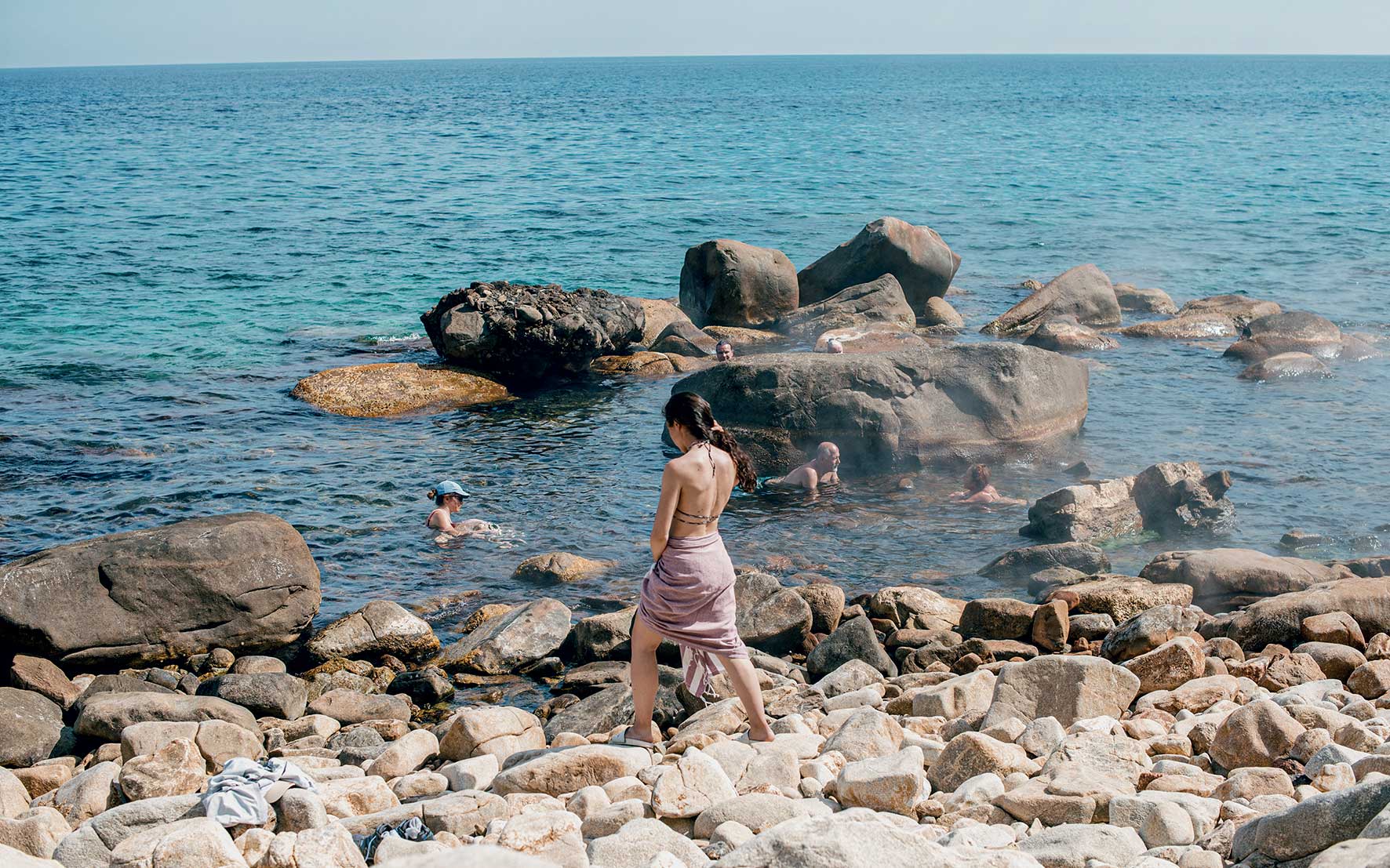
The natural hot springs send steam and a smell of sulphur into the air at Lefkada beach.
© Angelos Giotopoulos
My reason for visiting Ikaria was a longing to experience one of its famous panigyria (feast days) after two years of pandemic restrictions, but once I arrived it was the island’s other charms that won me over. The first was the natural beauty, a special combination of wild relief and rampant vegetation, which is unique in Greece. “A small continent” is how the island is described by Angelos Kalokairinos, a member of the Mountaineering Club of Ikaria. He explains the richness and variety of its landscapes with the fact that it sits right on the edge of the Asian tectonic plate, but also to the geological upheaval caused by the eruption of a large volcano on its southern edge, millions of years ago.
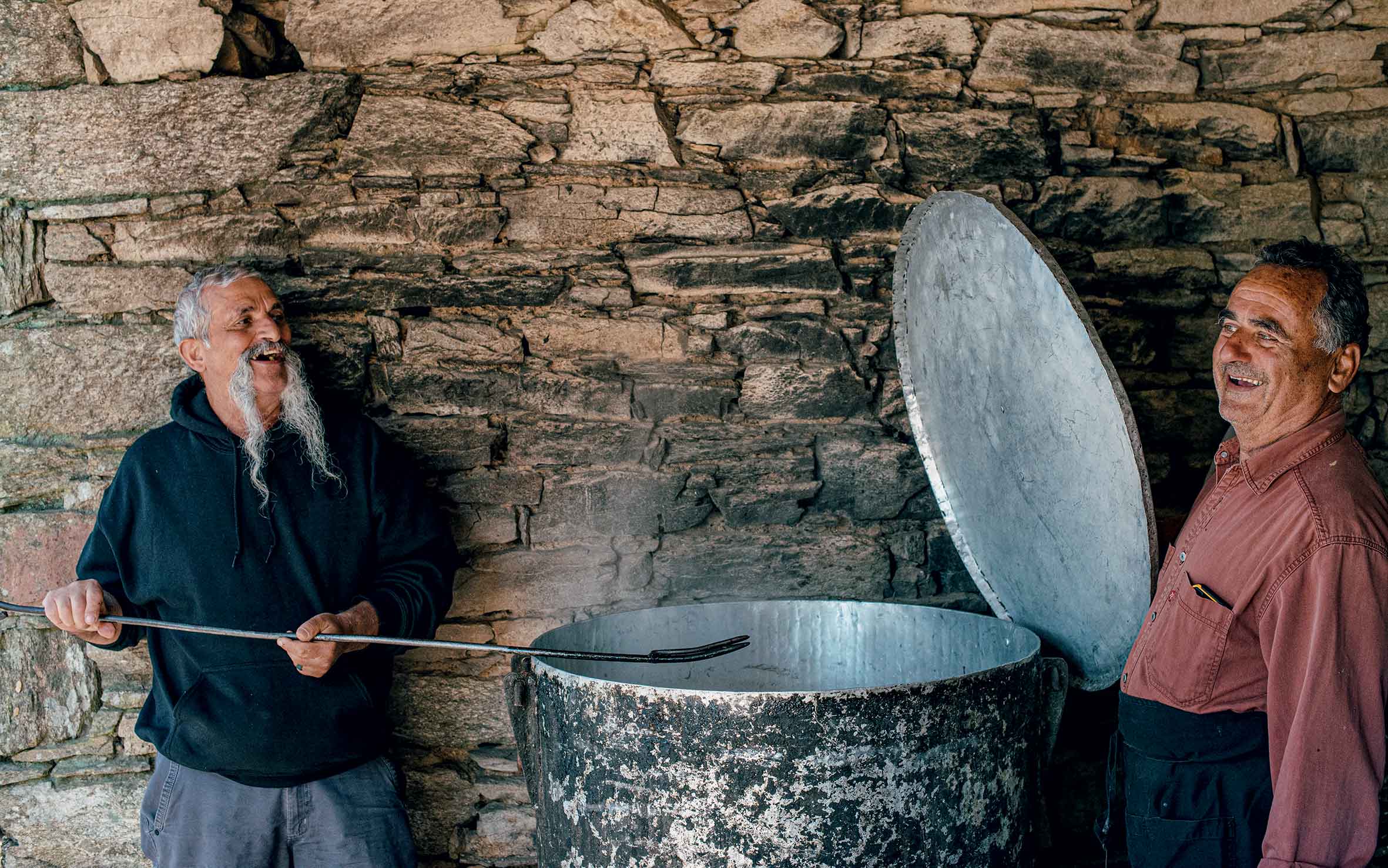
Inside the giant cauldron simmers the goat for the feast of Aghios Isidoros
© Angelos Giotopoulos
You experience this almost exotic beauty when you set your eyes on landscapes like Lefkada beach, a few kilometers west of Aghios Kirikos. The dirt track which descends from the main road gets you to the beach fast – and from then on you just need to balance on the large pebbles. After about a ten-minute walk to the right, steam rises from the sea and there is a smell of sulphur in the air from the natural hot springs which wash into the sea. The couple enjoying a soak stop me from jumping right in, explaining that the water right in front of me is scalding hot. They show me how to slip in, stepping onto a specific rock, and avoiding the limpets and the slippery surfaces. Ikaria’s beauty comes at a price.
I walk carefully, and as I sink gently into the warm water the sea feels like a warm hug. Soaking in the hot springs, I admire the impressive rocky hillcrest and get to know my fellow bathers: a Greek-American, an English woman and two Australians. We get to chatting and the conversation soon turns to the subject of “blue zones” – those special places around the globe known for the longevity of their inhabitants. This is the reason which drew them all to Ikaria.
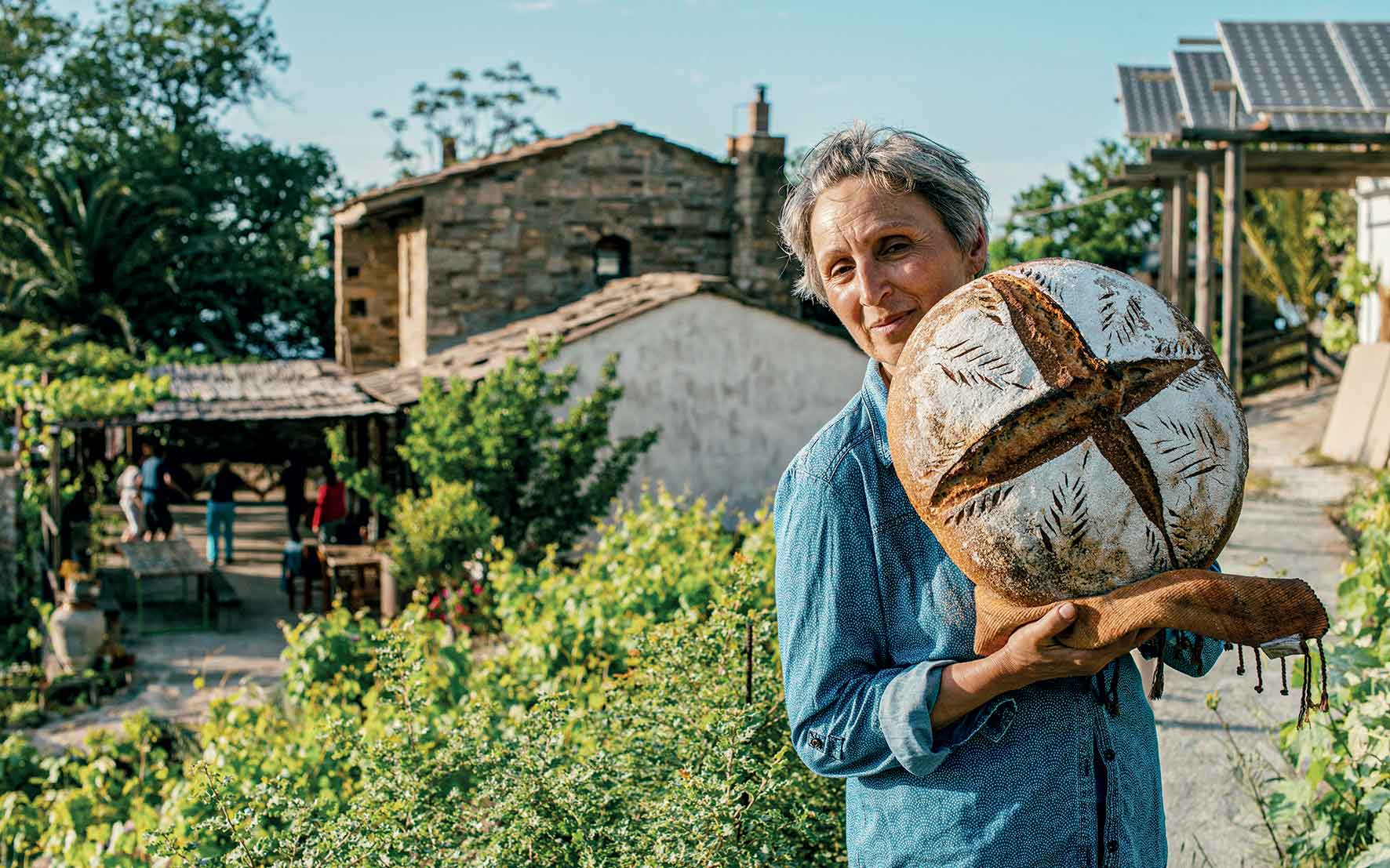
Sourdough bread and lessons in longevity from Eleni Karimali.
© Angelos GIotopoulos
Foreign visitors are inducted into the secretes of the “blue zone” at the Karimalis winery in Pigi, a few kilometers west of Evdilos. Located on a green slope facing the sea, the terraces on which the vines are planted resemble the seating rows in an ancient theatre. In these surrounds, Eleni Karimali offers lessons in Ikarian cooking, using techniques such as slow cooking, the use of sourdough starters, and the addition of olive oil at the end. As I follow her to place the clay pot with the gigantes (giant butter beans) in the wood oven, we pass her daughter Iliana, who is guiding a group of visitors around the winery. We walk together through the vines as the sun prepares to set, and she talks us through the features of local varieties, like Fokiano, Begleri and Kountouro. Fokiano is used to make the famous Pramnian wine, which has been synonymous with Ikaria since Homer’s time.
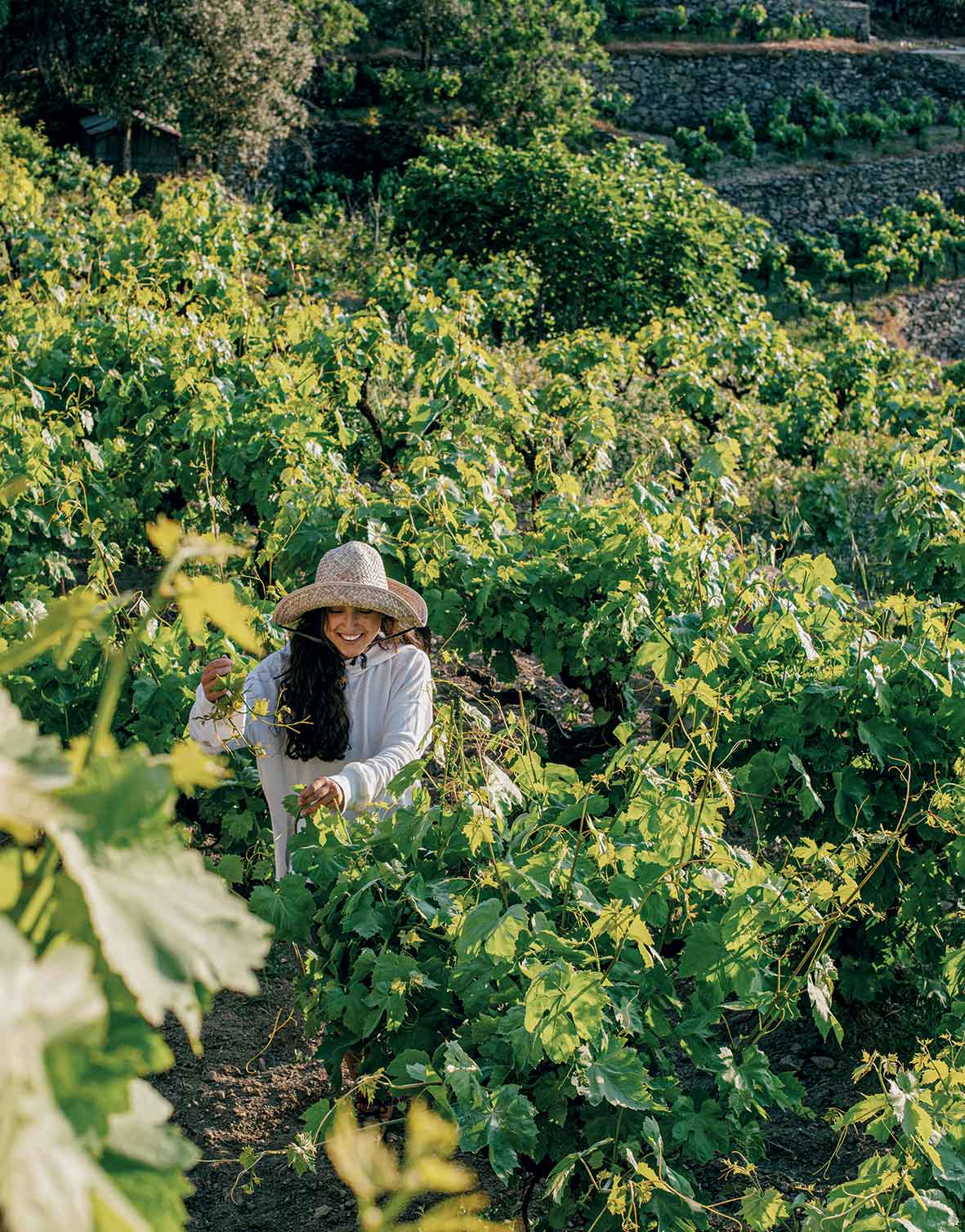
© Angelos GIotopoulos
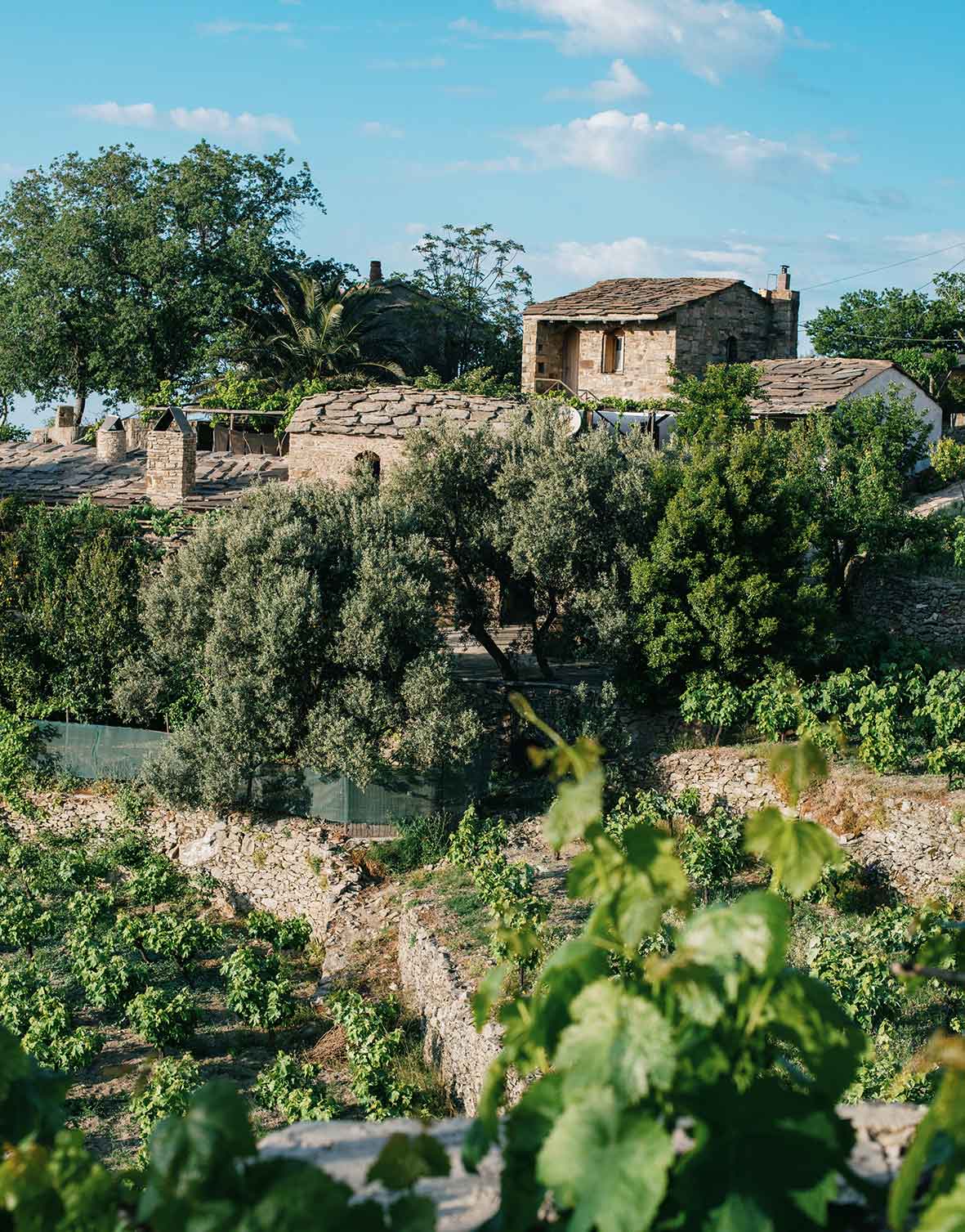
© Angelos GIotopoulos
Our stroll continues to the estate’s stone olive press, which is believed to be close to 1,200 years old, and concludes at the restaurant. Here, overlooking the vineyard and the sea, we taste delicious homemade dishes, such as caramelized gigantes, a pie of seasonal greens and soufiko, a vegetable bake which is the Ikariot twist on a dish known elsewhere as briam. Giorgos, the father of Iliana, explains that the salt on the table is soaked in grape must, which gives it probiotic qualities. It is one of several secrets of longevity shared with the guests on the estate’s retreats.
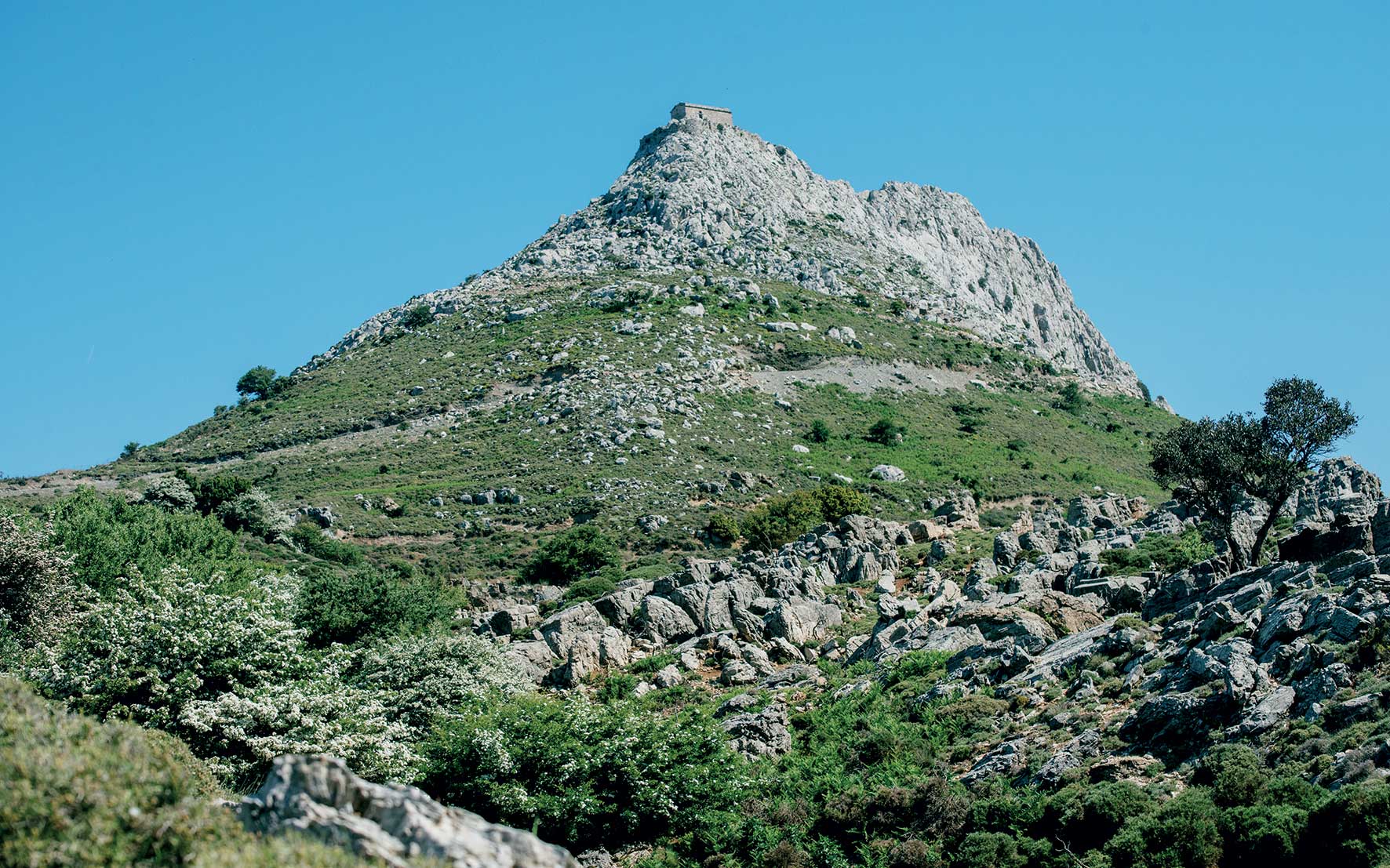
The castle of Koskinas.
© Angelos Giotopoulos
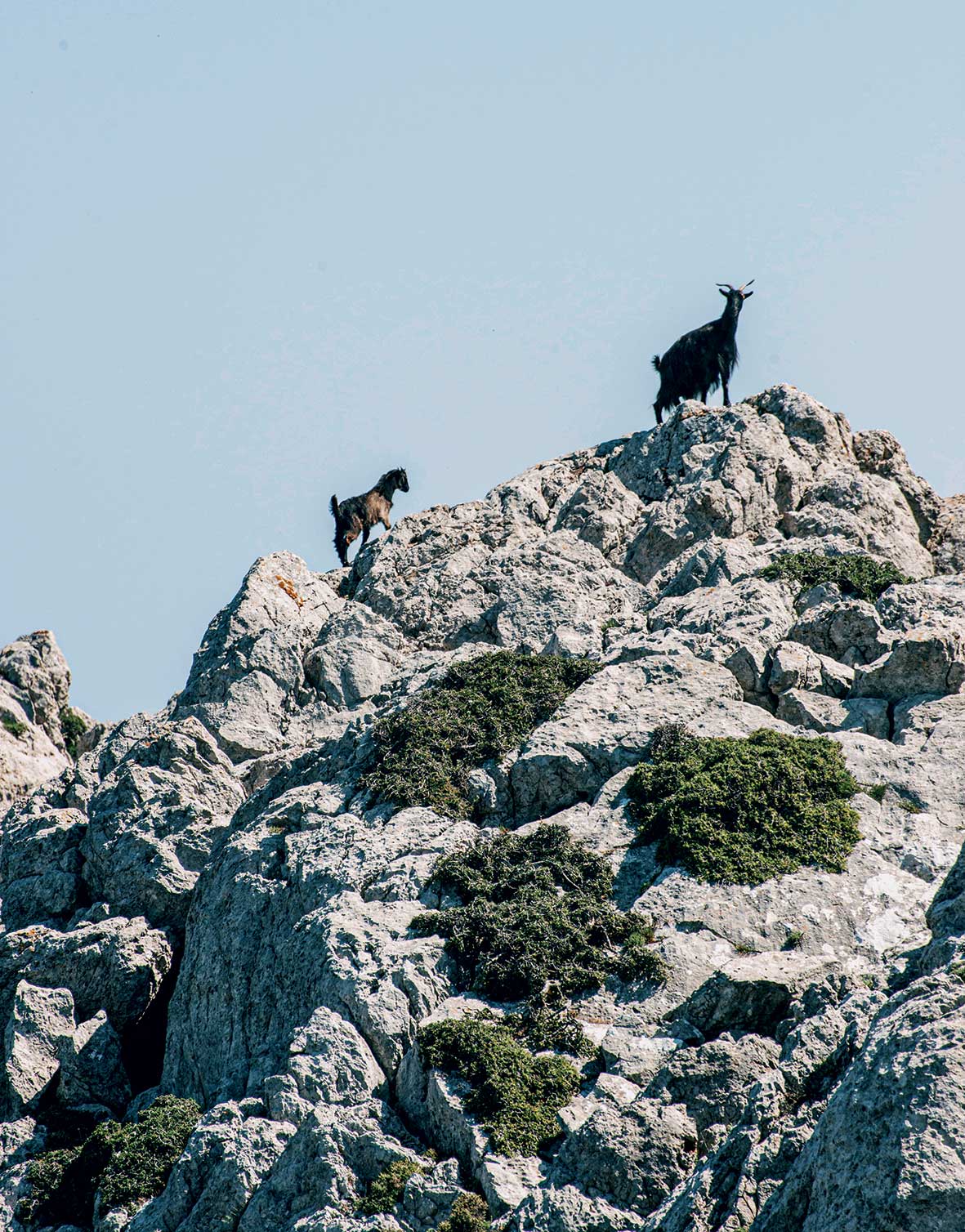
Wild goats spill out onto the rocks opposite the Aghios Georgios chapel at the top of Koskinas.
© Angelos Giotopoulos
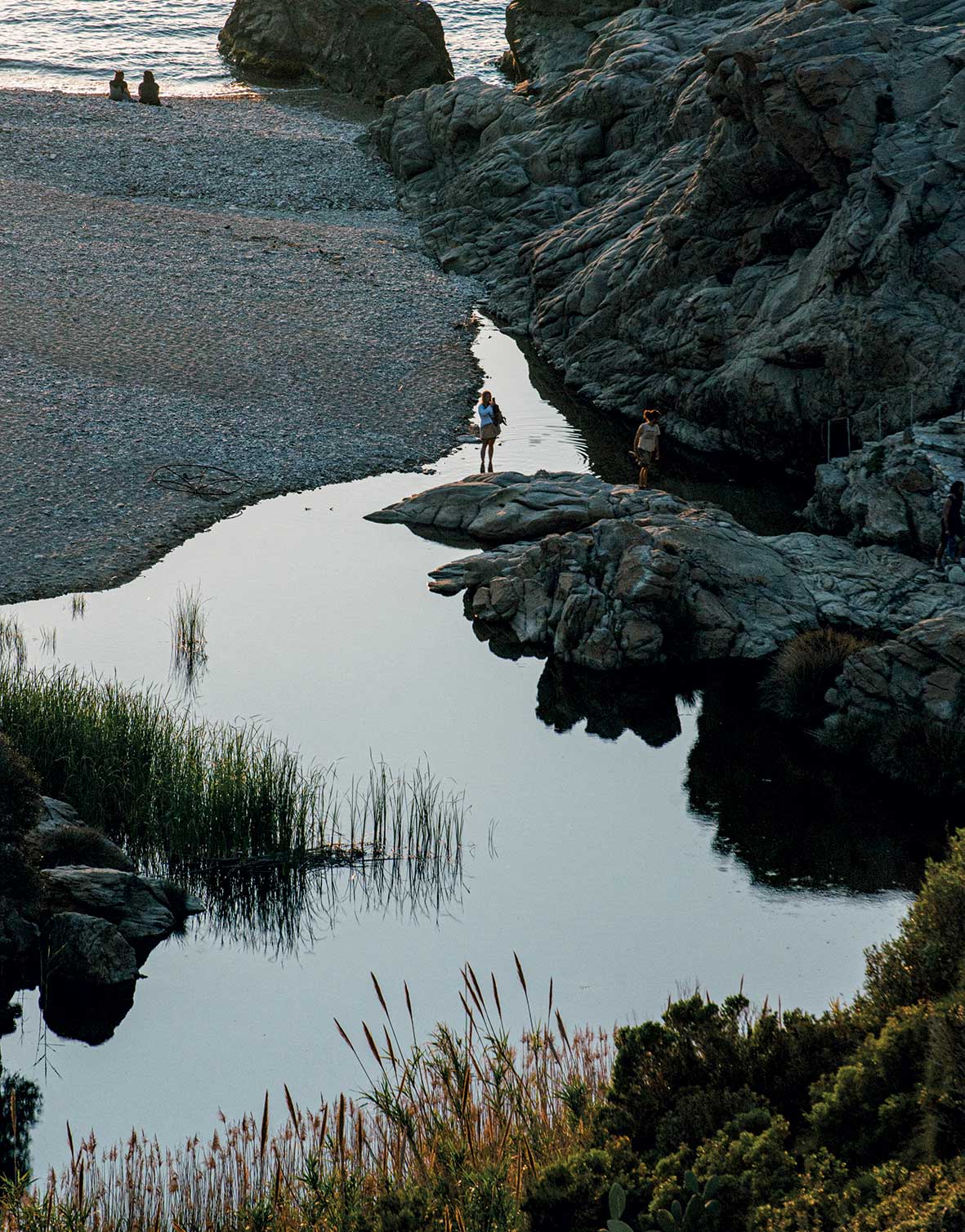
At Na beach, the river of Halari meets the sea in a place with peculiar natural formations, which was chosen thousands of years ago as the site of a temple dedicated to the goddess Artemis.
© Angelos Giotopoulos
On Iliana’s advice, we drive towards Mount Koskinas, on whose rugged peak once stood the fort which protected Ikariots from the pirates. Along the way, we marvel at the large granite boulders, but also the way some of them have been converted into monastic cells, farmers’ huts and chapels. Among them is the chapel of Theoskepasti, wedged between two giant rocks a little outside Pigi.
Hiking up towards the castle of Koskinas, the goat bells can be heard across the plain and our view is taken up by gardens and vineyards stretching around the conical peak of Koskinas. As we push open the metal gate on the stone archway a startled flock of goats spills out of the Aghios Georgios chapel, surrendering the castle without fight.
Nature is equally disarming at the beach of Na, on the northwest corner of Ikaria. The river which flows through the Halari gorge meets the sea in a location with such peculiar natural formations that it is not by chance it was chosen thousands of year ago as the site of a temple dedicated to the goddess Artemis. The rugged rocks surrounding the beach resemble the back of a sleeping dragon, dry scrubs brush the ruins of the temple and the silence invites you to listen to the sound of the wind in rushes. Where the temple’s columns once stood, a group of American women are engaging in mediation exercises. Just the sight of their still silhouettes in the surroundings is enough to bring about a sense of calm.
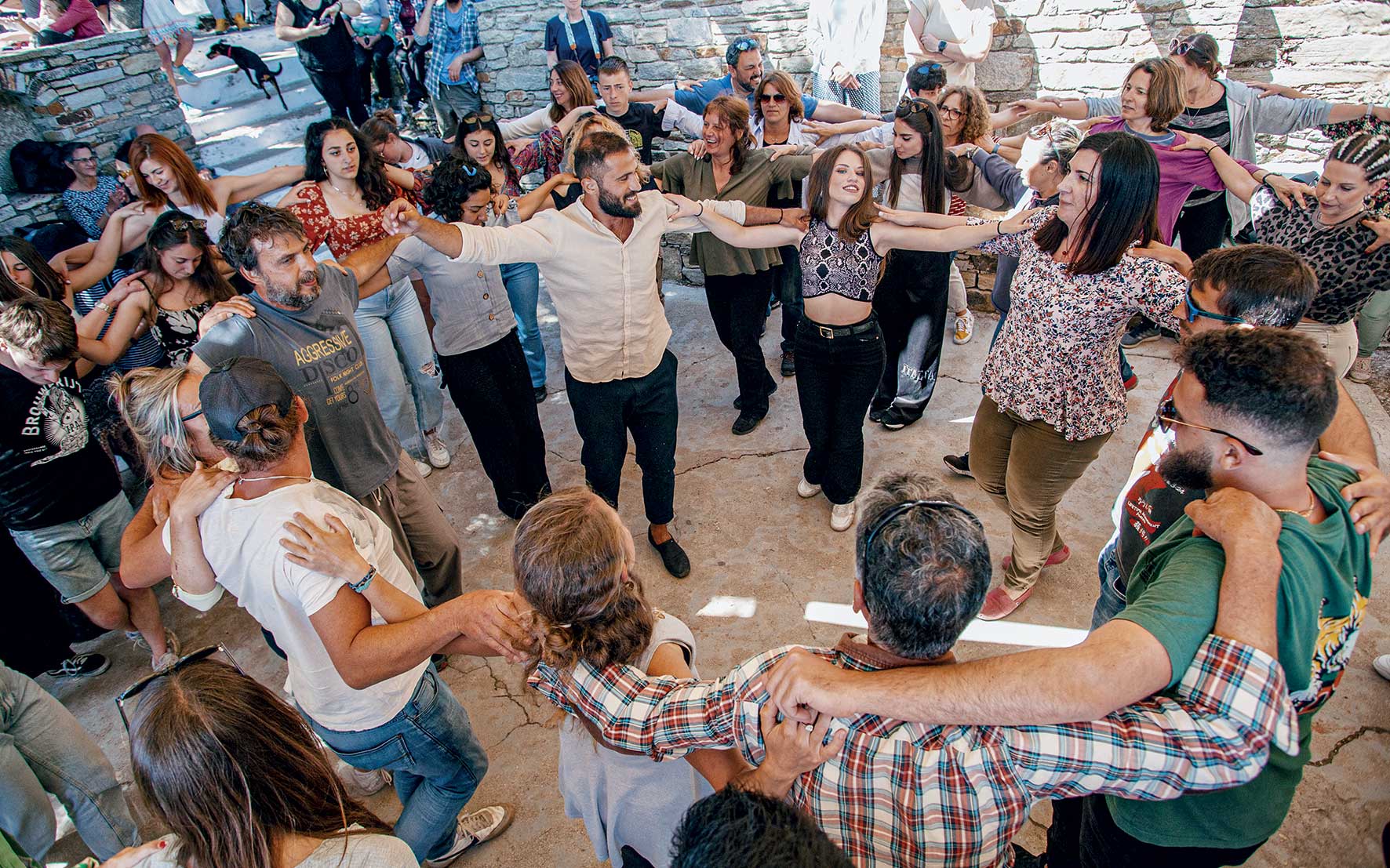
Dancing at the panigyri.
© Angelos Giotopoulos
The landscape in the southwest corner of Ikaria is granite and otherworldly. The sparse trees have been shaped by the wind which blows across the area, while the dirt road which descends towards the big blue leads you to the natural terrace where the chapel of Aghios Isidoros is located. The feast of Aghios Isidoros on May 14 marks the traditional starts of the summer panigyria on the island.
While the morning service is in progress, Makis, Stelios, Kostas and Simos shake the giant cauldron on which they are already preparing a goat stew, and fry potatoes for the 2,000 people who await. Makis fills our glasses with red wine of his own making, and Stelios makes arrangements for the collection of some hundreds of kilos of meat which are being roasted in bakeries in the surrounding area. The tables which have been set on the small terrace next to the chapel gradually fill up with people of all ages and nationalities. Among them, the couples we met at Lefkada beach, the American women from Na, Ikariots who have come from Athens for the celebrations, as well as groups of young people from the island. The panigyri is the occasion which unites all the “tribes” of Ikaria.
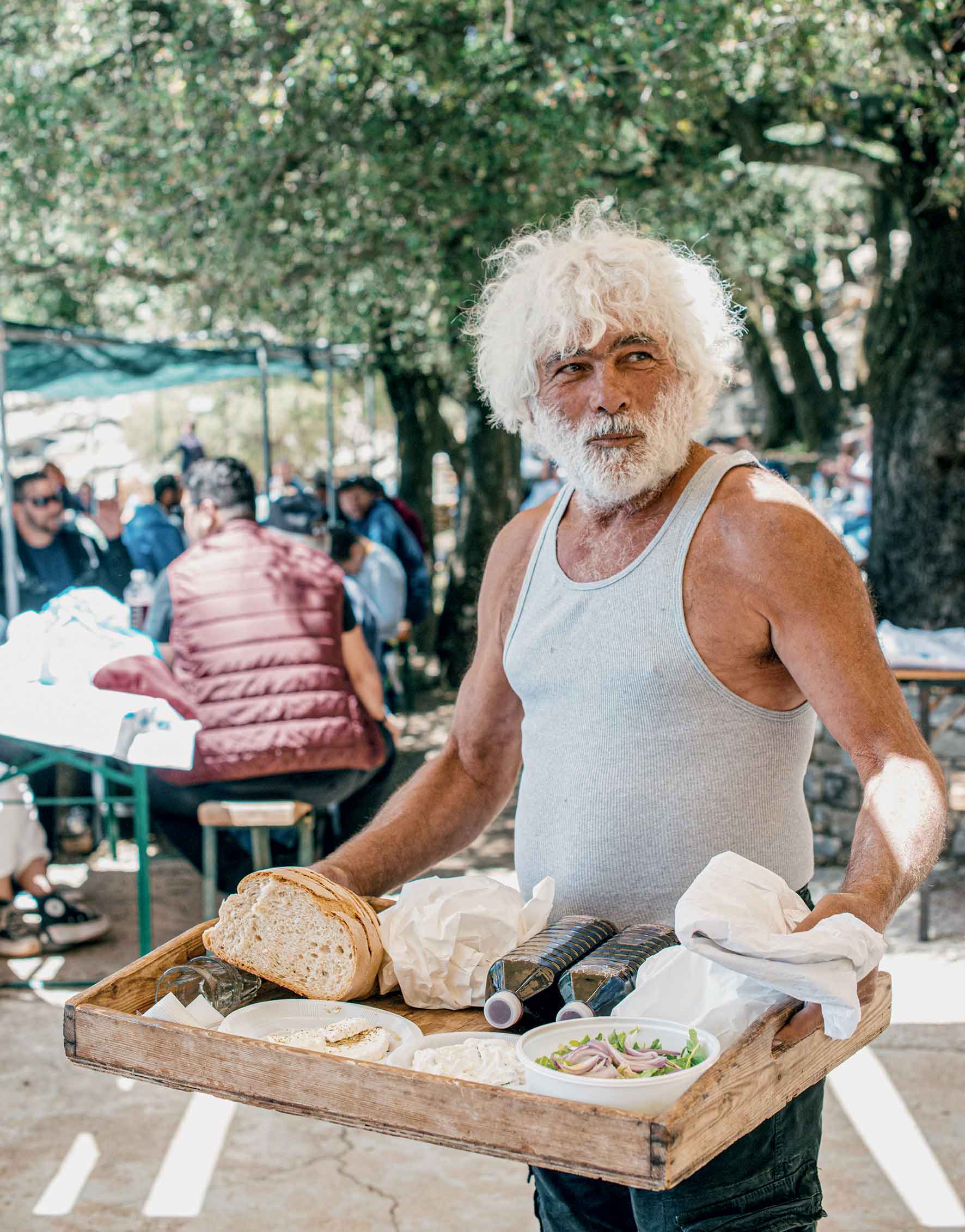
Food and dance into the early hours at the panigyri of Aghios Isidoros.
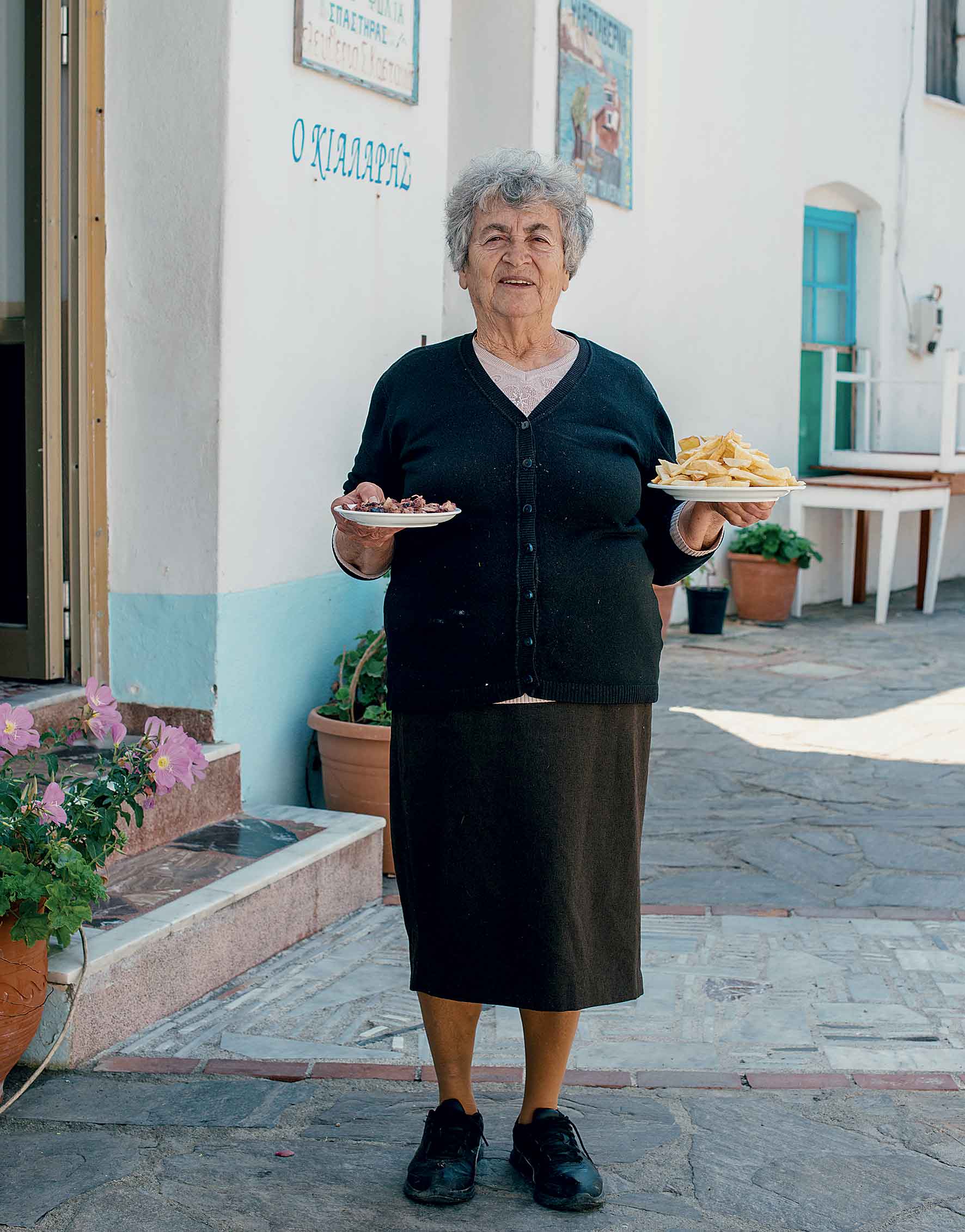
Kialaris
© Angelos Giotopoulos
A group of shepherds invite me to join them at their table, impatient for the live music to begin. As soon as the band strikes up, the dance floor fills with people swirling in concentric circles – more than you think the space would allow. The appetite for celebration has grown to gigantic proportions in the two years that they have been absent, which explains the marathon duration of the Aghios Isidoros feast.
The crowd continues to dance into the morning, to almost everything: from the traditional Ikariot and syrto steps, to the local, light versions of the waltz and the tango. The panigyri would continue to be the main topic of conversation in the village squares in the days that followed – until preparations for the next one began.
GETTING THERE
You will reach Ikaria by air on Sky Express and Olympic Air. Indicative price: 160 euros return. The journey by boat from Piraeus to Aghios Kyrikos takes between 6 and 13.5 hours (from 43 euros one way, with Blue Star Ferries or Hellenic Seaways) and from Piraeus to Evdilo 6 hrs 45 minutes (54.40 euros one way, with Blue Star Ferries).
WHERE TO STAY
Erofili Beach Hotel (Armenistis, Tel. (+30) 22750.710.58, from 85 euros). A modern hotel with traditional elements, located by the sea.
Toxotis Residences (Armenistis, Tel. (+30) 22750.715.70, from 90 euros). Contemporary design residences with a sea view.
Karras Star Hotel (Avlaki Kalamourida, Tel. (+30) 22750.710.24, from 60 euros). Seaside hotel located between Evdilo and Gialiskari.
FOOD
Sto Kampi (Aghios Dimitrios, Tel. (+30) 22750.416.41). Traditional Ikariot cuisine and modern dishes on the pretty square of Aghios Dimitrios in Raches.
Mary Mary (Armenistis, Tel. (+30) 22750.715.95). The menu includes traditional flavours such as kathoura (a local goat’s cheese) and soufiko, as well as meat dishes and pasta.
Karimalis Farmhouse Restaurant (Pigi, Tel. (+30) 694.350.6951). Home cooking with plenty of vegetarian options, in an idyllic setting among the estate’s vineyards.
Kialaris (Gialiskari, Tel. (+30) 22750.712.27). Quaint little fish taverna with a short menu focussing on fresh fish, ideal for ouzo with a sea view.
Women’s Cooperative of Christos Rachon (Christos, Tel. (+30) 22750.410.76). Traditional and contemporary sweets and coffee, handmade by the cooperative members.
PANIGYRIA
There is a panigyri almost every other week through the summer. Among them, Aghia Marina in Arethousa on July 17, Profitis Ilias in Raches on July 20, Aghia Parakevi in Petropouli in July 26, Tou Sotira at Christos Rachon on August 6, Aghios Fanourios in Aghios Dimitrios on August 27, and the mega-panigyri at Langada on August 15, and also Plagia on September 8. Participants pay for food and drink, with proceeds going to the local organising committee.
HIKING TRAILS
The wild mountainous landscape of Ikaria is criss-crossed by a dense network of walking trails which were used by locals until the 1970s when the first paved roads were built on the island. One of the most popular walks is along the Halari gorge, where the water flows year-round, carving out spectacular landscapes. It is also possible to walk the entirety (or sections of) of the 50 km of the crest of Mount Atheras which stretches from one end of the island to the other. The Hiking and Mountaineering Club of Ikaria (Tel. (+30) 697.203.1006) publishes maps of the trails which are available at opsikarias.blogspot.com, while it also provides mountain guides.
From kafeneia serving souma and meze...
A weekend on the Saronic Gulf’s...
Discover festivals, beaches, food, and hidden...
A decades-old ritual, Sikinos’ ferry dives...